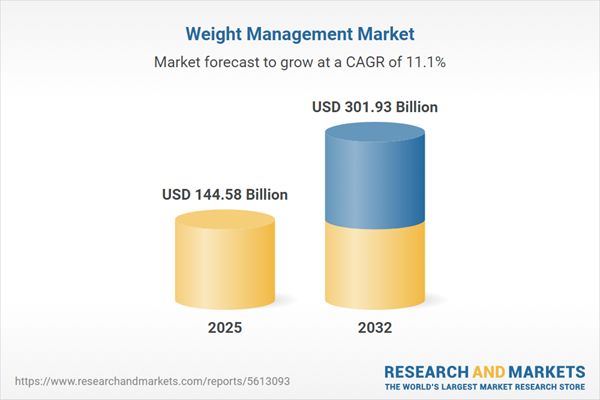Speak directly to the analyst to clarify any post sales queries you may have.
The weight management market is rapidly evolving as organizations accelerate digital transformation, adapt to ongoing regulatory updates, and pursue innovation to align with dynamic wellness trends. Senior decision-makers are proactively reshaping their business strategies to maintain competitiveness in this shifting landscape.
Market Snapshot: Weight Management Market Growth and Outlook
The weight management market is experiencing robust growth, propelled by advancements in digital health and a stronger emphasis on holistic wellness solutions. Recent market research identifies a substantial total market size and an attractive compound annual growth rate (CAGR), capturing heightened investor attention and motivating organizations to expand their market footprint. As businesses respond, operating models are becoming more adaptable, integrating cutting-edge technologies to address evolving regulatory mandates and rising client expectations. Companies strategically diversify offerings and elevate customer service as differentiation becomes more challenging. The industry is implementing flexible compliance practices, and interregional expansion highlights the importance of digital engagement and tailored market approaches for lasting success.
Scope & Segmentation Across the Weight Management Industry
- Meal Replacement Products: An expanding range of meal bars, shakes, and soups provides personalized nutritional solutions, serving diverse dietary needs and supporting changing health habits for consumers and organizations seeking flexibility in nutrition programming.
- Dietary Supplements: Growing interest in plant-based, herbal, and vitamin-enriched supplements encourages preventive health practices and appeals to a wide spectrum of health-focused individuals, aligning with broader wellness objectives.
- Fitness Equipment: Innovations in both home and commercial fitness equipment enable flexible and personalized exercise plans, increasing access regardless of user location and supporting hybrid work and wellness routines.
- Weight Loss Programs: Comprehensive solutions, including clinics, digital applications, and telehealth services, empower clients to select tailored strategies, facilitating adaptable weight management journeys.
- Prescription Drugs: Pharmaceutical therapies are frequently incorporated alongside behavioral and nutritional interventions, supporting integrated approaches to improved weight management outcomes.
- Regional Markets: Key regions such as the United States, Canada, Germany, India, and China drive the necessity for local customization and targeted go-to-market strategies, with adaptability and regional engagement emerging as competitive priorities.
- Technological Innovations: Developments in digital health, plant protein optimization, and connected devices enhance customer involvement, generate actionable data insights, and enable companies to adapt more efficiently to market shifts.
- Company Coverage: Leading players like Novo Nordisk A/S, Eli Lilly and Company, WW International, Herbalife Nutrition, Medifast, Abbott Laboratories, Danone, Nestlé, Kellogg, and USANA Health Sciences shape industry direction and competitive benchmarks.
Key Takeaways for Senior Decision-Makers
- Strategic collaborations increasingly integrate nutrition, exercise, and medical therapies, creating resilient business models and helping companies address a broadening array of customer requirements.
- Advanced analytics and artificial intelligence improve the ability to anticipate consumer preference shifts, enabling organizations to refine commercial strategies and operational processes promptly.
- Well-managed, compliant supply chains support companies in adapting to regional and international regulatory changes, helping sustain business continuity and reinforce trust among stakeholders throughout the value chain.
- Prioritizing responsible sourcing and transparent operations enhances organizational credibility and meets growing stakeholder expectations for sustainability across the industry ecosystem.
- Expanding digital and telehealth service models increases customer interaction and provides new pathways for differentiation in a highly competitive sector.
Tariff Impact on Weight Management Product Supply Chains
Recent changes in U.S. tariff policies for plant proteins, specialty fibers, and fitness equipment have required companies to reassess sourcing and distribution strategies. To strengthen supply chain resilience, organizations are forming more domestic supplier relationships, diversifying procurement sources, and relocating logistics infrastructure nearer to major demand areas. This approach supports regulatory alignment and efficient distribution. Additionally, combining digital and pharmaceutical delivery methods streamlines supply chains, enabling companies to adjust efficiently to regulatory shifts within priority regions.
Methodology & Data Sources
This analysis integrates insights from executive interviews, sector specialist panels, and real-time analytics complemented by in-depth industry dialogues. The methodology adheres to established industry standards, delivering relevant guidance for decision-makers within the weight management sector.
Why This Report Matters
- Enables robust benchmarking of organizational performance and readiness in a continually shifting regulatory landscape.
- Provides actionable segmentation-based insights, equipping leaders to design scalable and precise business strategies for ongoing market shifts.
- Supports successful digital transformation and forward-thinking risk management, ensuring organizational responsiveness to evolving trends and compliance demands.
Conclusion
Agility through innovation and regulatory alignment equips organizations with the structure to succeed in the fast-changing weight management market. Focused planning and strong operational execution will underpin leadership and sustained growth.
Additional Product Information:
- Purchase of this report includes 1 year online access with quarterly updates.
- This report can be updated on request. Please contact our Customer Experience team using the Ask a Question widget on our website.
Table of Contents
3. Executive Summary
4. Market Overview
7. Cumulative Impact of Artificial Intelligence 2025
Companies Mentioned
The companies profiled in this Weight Management market report include:- Novo Nordisk A/S
- Eli Lilly and Company
- WW International, Inc.
- Herbalife Nutrition Ltd.
- Medifast, Inc.
- Abbott Laboratories
- Danone S.A.
- Nestlé S.A.
- Kellogg Company
- USANA Health Sciences, Inc.
Table Information
| Report Attribute | Details |
|---|---|
| No. of Pages | 199 |
| Published | October 2025 |
| Forecast Period | 2025 - 2032 |
| Estimated Market Value ( USD | $ 144.58 Billion |
| Forecasted Market Value ( USD | $ 301.93 Billion |
| Compound Annual Growth Rate | 11.1% |
| Regions Covered | Global |
| No. of Companies Mentioned | 11 |









